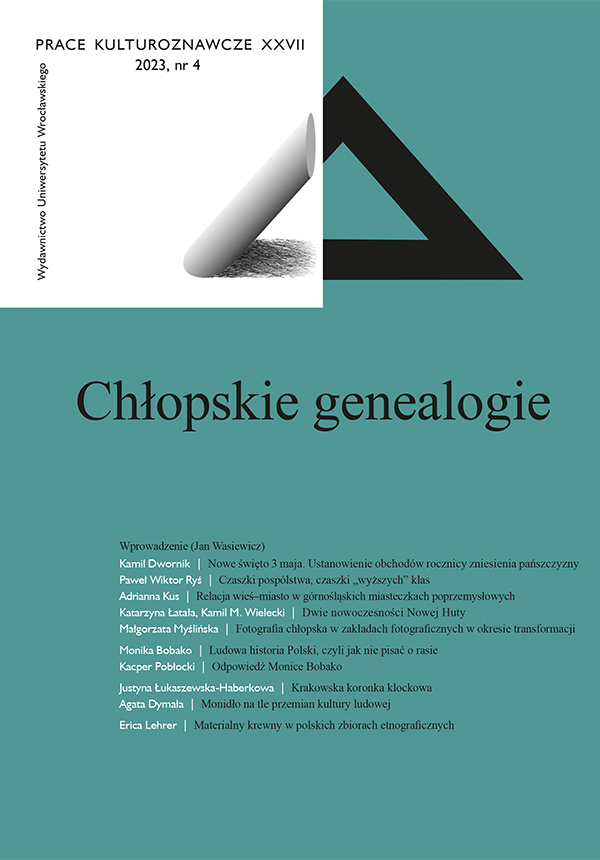

Articles

The thesis we defend in this article is twofold. Firstly, we argue that Nowa Huta has gone through two modernities—one socialist and one post-socialist. This district of Kraków is a nodal point where these two modernities—and perhaps more—intertwine and clash with each other. Secondly, we claim that Nowa Huta is a material sign of the continuity and rupture of Polish history. It stands at the center of Polish disputes over identity, in which the sides always have to somehow take a stance on the socialist past.
For some, Nowa Huta is a symbol of a criminal system imposed by the Soviet occupier, of the social engineering to which Polish society was subjected, and a synonym of ugliness. Albeit also the place of the “struggle for the cross” and resistance which the working class put up to the party which allegedly represented it. For others—a site of cultural heritage which needs to be protected, implementation of progressive ideals of social justice, and currently the greenest district of Kraków.
The theoretical foundations of our thesis are Shmuel Eisenstadt’s theory of multiple modernities and Susanne Brandtstädter’s theory of two modernities. We begin by describing the socialist modernity in Nowa Huta, based on the narratives of the propaganda and critical art of the period. Then, we move on to the post-socialist modernity and analyse the changes that the district of Nowa Huta and the discourse about it underwent as a result of the political and social transformation. Finally, we compare post-socialist modernity with socialist modernity.
Berman M., Wszystko, co stałe rozpływa się w powietrzu. Rzeczy o doświadczeniu nowoczesności, przeł. M. Szuster, Kraków 2006.
Brandtstädter S., Transitional spaces: Postsocialism as a cultural process. Introduction, „Critique of Anthropology” 2007, nr 2, s. 131–145.
Buchowski M., Widmo orientalizmu w Europie. Od egzotycznego Innego do napiętnowanego swojego, „Recycling Idei” 10, 2008, s. 98–107.
Burawoy M., Multicase ethnography: Tracking the demise of state socialism, [w:] M. Burawoy, The Extended Case Method: Four Countries, Four Decades, Four Great Transformations, and One Theoretical Tradition, Berkeley 2009.
Eisenstadt S.N., Nowoczesność jako odrębna cywilizacja, [w:] Współczesne teorie socjologiczne, red. A. Jasińska-Kania, L.M. Nijakowski, J. Szacki, M. Ziółkowski, t. 2, Warszawa 2006, s. 754–768.
Eisenstadt S.N., Utopia i nowoczesność. Porównawcza analiza cywilizacji, przeł. A. Ostolski, Warszawa 2009.
Golonka-Czajkowska M., Nowe miasto nowych ludzi. Mitologie nowohuckie, Kraków 2013.
Habermas J., Modernizm — niedokończony projekt, przeł. M. Łukasiewicz, [w:] Postmodernizm. Antologia przekładów, red. R. Nycz, Kraków 1996, s. 25–46.
Hastrup K., Przedstawianie przeszłości. Uwagi na temat mitu i historii, „Polska Sztuka Ludowa. Konteksty” 1997, nr 1–2, s. 22–28.
Janas K., Nowa Huta. Przestrzeń tożsamości, Warszawa 2020.
Kenney P., Budowanie Polski Ludowej. Robotnicy a komuniści 1945–1950, przeł. A. Dzierzgowska, Warszawa 2015.
Lebow K., Unfinished Utopia: Nowa Huta, Stalinism, and Polish Society, 1949–56, Ithaca 2013. Leder A., Prześniona rewolucja. Ćwiczenia z logiki historycznej, Warszawa 2014.
Legutko R., Esej o duszy polskiej, Kraków 2008.
Leyk A., Wawrzyniak J., Cięcia, Warszawa 2020.
Myczkowski Z. et al., Plan ochrony Parku Kulturowego Nowa Huta, etap I, cz. 1, Urząd Miasta Krakowa 2015.
Pozniak K., A model socialist steel town enters the neoliberal age: The changing political economy of Nowa Huta, Poland, „Economic Anthropology” 2, 2015, s. 63–83.
Pozniak K., Reinventing a model socialist steel town in the neoliberal economy: The case of Nowa Huta, Poland, „City & Society” 1, 2013, s. 113–134.
Pudełko A., Tematyzacja rewitalizowanej przestrzeni — problem czy konieczność?, „Zarządzanie w kulturze” 16, 2015, s. 389–401.
Rausig S., Re-constructing the ‘normal’: Identity and the consumption of Western goods in Estonia, [w:] Marketes and Moralities: Ethnographies of Postsocialism, red. R. Mandel, C. Humphrey, Oxford 2002.
Rymkiewicz W., Czy Peerel jest częścią polskiej historii?, „Kronos. Metafizyka-Kultura-Religia” 2008, nr 4, s. 259–274.
Salwiński J., Powstanie i rozwój Nowej Huty w drugiej połowie XX wieku, [w:] Kraków. Nowe studia nad rozwojem miasta, red. J. Wyrozumski, Kraków 2007.
Spór o PRL, red. P. Wandycz Kraków 1996.
Stanek Ł., Simulation or hospitality — beyond the crises of representation in Nowa Huta, [w:] Encountering Urban Places, red. L. Frers, London 2007.
Stenning A., Post-socialism and the changing geographies of the everyday in Poland, „Transactions of the Institute of British Geographers, New Series” 2005, nr 1, s. 113–127.
Stenning A., Re-placing work: economic transformations and the shape of a community in post-socialist Poland, „Work, Employment and Society” 2005, nr 2, s. 235–259.
Stenning A., Where is the post-socialist working class? Working-class lives in the spaces of (post-)socialism, „Sociology” 39, 2005, s. 983–999.
Sulimski J., Kraków w procesie przemian, Kraków 1976.
Szcześniak M., Poruszeni. Awans i emocje w socjalistycznej Polsce, Warszawa 2023.